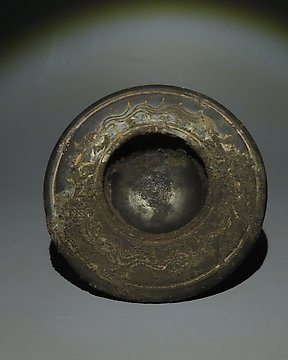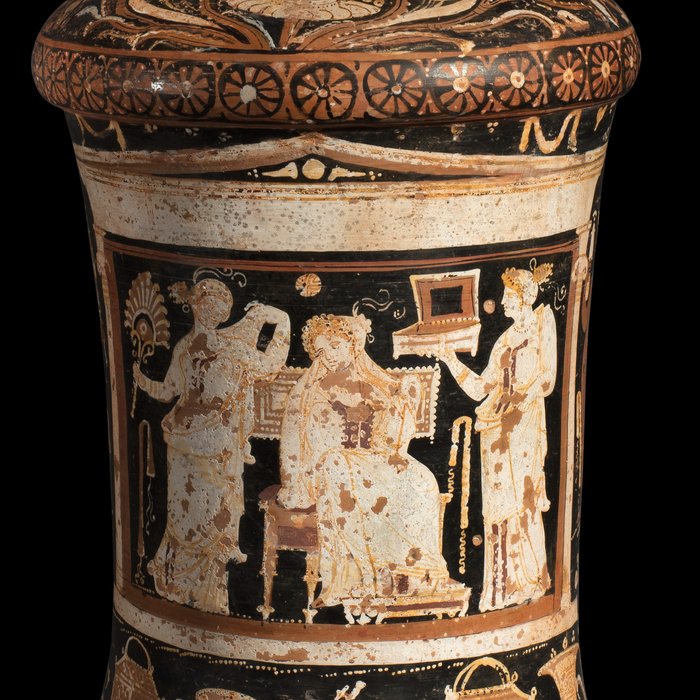
Antico Greco Ceramica Piatto con decoro inciso. IV secolo a.C. 5,5 cm di altezza.
N. 82680333

N. 82680333

WEDDING LOUTROPHOROS
Magna Graecia, Apulia, c. 320 BC
Pottery
Height 87 cm
Provenance:
- Private collection of the painter Lionel Perrotte (1949 - 2020), France.
Condition:
DOCUMENTS: - Attached thermoluminescence test, french export permit issued by the Ministry of culture in France and Spanish export permit issued by the Ministry of culture in Spain.
DESCRIPTION:
This vase shows a very elegant, almost symmetrical formal scheme: the centre is the large cylindrical body, which is carved and finished at the top and bottom with two sets of similar shapes: a cup-shaped base and shoulders, and a narrow foot and neck that open out to form a disc. However, the lower part of the vessel is smaller, and is also less decorated: only a meandering border on the upper part of the bowl that finishes off the foot, differentiating it from the main body. The rest is simply coloured in black. The shoulders and neck, on the other hand, are comparatively larger in diameter and richly ornamented. The shoulders form a cone that curves and narrows to form a stylised neck, divided in two by a thin central moulding. The upper part of the neck opens out again to support a large, flat, circular mouth. This clear differentiation between the upper and lower areas, which is typical of Greek ceramics, can also be seen in the delicately asymmetrical profile of the central body, which makes the lower area of the vessel appear visually narrower.
This is a loutrophoros or lutrophore, a vessel originating from Greek pottery used to contain bathwater. It is characterised by its elongated, wide neck and originally had two vertical handles. In this case it can be classified in the subgroup of 'barrel amphorae', without handles and with a barrel-shaped body.
Traditionally linked to the female sphere, the loutrophoros was already used in Greece to carry the water used in women's ritual baths, mainly at two moments: marriage and death. These baths would purify the bride, cleansing her of her former life and also promoting her fertility, as well as preparing the deceased for her journey to the afterlife. The origin of the loutrophoros is to be found in the Greek Archaic period, but it enjoyed a special development in Magna Graecia. In Apulia, this type of vessel began to appear, mainly in female funerary offerings, from the mid-4th century BC. Numerous examples have been found, all of them vessels of great importance due to their size, the quality of their manufacture and the high level of their pictorial decorations. It is also likely that these rich loutrophoroi were displayed during funeral ceremonies, before being buried next to the deceased.
The decoration, in the red-figure technique enriched with large areas of white and ochre details, is dominated by a large main scene in the body. This is an architectural scene topped by an entablature and a triangular pediment (naiskos), under which three women are seated. The woman in the centre, the protagonist, is seated on a carved wooden chair with a large horizontal back that protrudes behind her back. On either side of her, two shelving maidens gaze down at her. One of them carries a feather fan and raises her veil over her shoulder, a conventional gesture known as anakalypsis, symbolising revelation and indicating her status as a bride. The other lady holds an open jewellery box in her right hand. All three are dressed in delicate garments that form fine folds around their chests and legs. The seated woman wears her curly hair tied back, covered with a veil knotted at the nape of her neck. Her companions wear more conventional, though equally elaborate, hairstyles. As is common in Apulian ceramics, the flesh tones of these three women are coloured white. On either side of this temple or naiskos are two more figures, a man and a woman, in this case red figures, without white or ochre pigments. She holds a large mirror and a small mirror, and he holds a thin rod and a sceptre.
Below this main scene is a band with a black background on which various objects related to the world of women stand out: alabastrons, a loom, a cylindrical boat, two chests and a kalathos. These objects are particularly prominent, both because of their orderly and clear arrangement in the form of a frieze and because of their detailed description. They symbolically reflect the status of the female protagonist: the alabastrons and chests allude to female kosmesis and jewellery, while the kalathos represents the domestic work of high-ranking ladies, emphasising the female identity, the economic activity of women within the family oikos and, therefore, their social identity.
Continuing with the decoration on the front, the shoulder area houses a bust-length female portrait, a lady with her hair tied back, her face gracefully tilted to her right. Around her are intricate vegetal motifs, including ribbons painted in two colours to suggest three-dimensionality. Below this central band, which houses the bust, is a simpler band of rosettes. At the neck, alternating bands of stylised triangular leaves, sea waves and a palmette.
The decoration on the back of the piece is notably simpler, mainly in its colouring, which is reduced to the traditional red and black scheme. The back is decorated with larger vegetal motifs, which cover from the mouth to the lower part of the body.
In her study of the Baltimore painter's loutrophoroi, Monica Baggio situates them in a funerary context. The author points out that the use of naiskos gives the representation an eminently funereal character, while at the same time heroifying the deceased depicted. She also points out that the use of dense white pigment for the flesh tones, typical of the Baltimore painter, not only responds to the feminine ideal of pallor, but also evokes the marble of the statues of the deceased that were usually placed inside the naiskoi. On the other hand, the objects in the lower frieze correspond to both the funerary and the marriage scene, two moments in which the loutrophoroi functioned as a key ritual vessel. Both were crucial occasions in a woman's life, rites of passage, liminal, and therefore of special symbolic significance.
The Baltimore Painter, active in the last quarter of the 4th century BC, was one of the protagonists of the so-called Late Apulian phase, and is considered the last great painter of Apulian ceramics. His conventional name derives from a scroll krater in the Walters Art Museum in Baltimore, USA. He was heir to the workshops of the painters of Darius and the Inferno, and developed his production in the northern part of Apulia, around the towns of Ruvo, Canosa and Arpi, at a time when the centre of Apulian pottery manufacture shifted from Taranto to the northern towns, in the search for new clients among the local aristocracy, now Hellenised, who used painted ceramics as a vehicle for social affirmation and legitimisation.
The Baltimore painter decorated large-format vessels: volute craters, amphorae, loutrophoroi and hydria. He mainly depicted funerary scenes (naiskos vessels), although pieces by his hand have also been found with mythological scenes, wedding scenes and scenes from everyday female life. Stylistically he developed a meticulous language of detail, especially in ornamental motifs.
The region of Apulia, north of the Gulf of Tarentum and east of the Apennine Mountains, was the main centre of production of painted pottery in Magna Graecia. Two parallel styles developed there: one called the Simple Style and the other known as Ornamented. The former avoided the use of colours other than the basic red and black, and was mainly used for small vessels such as the bell-shaped krater. This style became more complicated as time went on, and by the mid-4th century BC it was very similar to the Ornate style. This style was mainly used for larger vessels, such as volute craters, amphorae, loutrophoroi and hydrias. Compositions in this style depicted up to twenty figures, many of them floating, without a ground plane, and often arranged in two or more registers. This style was also characterised by a rich use of colour, with red, ochre and white being particularly prominent.
Red-figured pottery was one of the most important figurative styles of Greek production. It was developed in Athens around 530 BC, and was used until the 3rd century BC. It replaced the previous predominant style of black-figure pottery within a few decades. The technical basis was the same in both cases, but in the red figures the colouring is inverted, with the figures highlighted against a dark background, as if illuminated by a theatrical light, following a more natural pattern. Painters working with black figures were forced to keep the motifs well separated from each other and to limit the complexity of the illustration. The red-figure technique, on the other hand, allowed greater freedom. Each figure was silhouetted against a black background, allowing painters to portray anatomical details with greater accuracy and variety.
The technique consisted of painting the motifs on the still-wet piece, using a transparent varnish which, when fired, took on an intense black hue. The motifs were therefore invisible before firing, which meant that the painters had to work entirely from memory, unable to see their previous work. Once the piece was fired, the unglazed areas remained with the reddish hue of the clay, while the glazed, "painted" areas took on a dense, glossy black colour.
In the case of this amphora, the traditional scheme of red figures on a black background is enriched by the addition of white and ochre pigments, not only for secondary details but also occupying large surfaces, such as the flesh tones of the two women and the chiton worn by one of them.
- BAGGIO, M. “Il mondo al femminile nel repertorio figurativo apulo. La prospettiva degli oggeti”, en Vasi immagini collezionismo. Università degli Studi di Torino. 2008.
- BAGGIO, M. “Sistemi di immagini, sistemi di oggetti. Le loutrophoroi del pittore di Baltimora”. Mondes Anciens, 4. 2013.
- BOARDMAN, J. The History of Greek Vases: Potters, Painters, Pictures. Thames & Hudson. 2001.
- Corpus Vasorum Antiquorum. Paris: Union Académique Internationale, www.cvaonline.org
- DENOYELLE, M.; IOZZO, M. La céramique grecque d’Italie Méridionale et de Sicile. A. J. Picard. 2009.
- MAYO, M. (ed.). The Art of South Italy, Vases from Magna Graecia. Richmond. 1982.
- TRENDALL, A. D. Red Figure Vases of South Italy and Sicily. Thames & Hudson. 1989.
- TRENDALL, A. D.; CAMBITOGLOU, A. First Supplement to the Red-Figured Vases of Apulia. University of London, Institute of Classical Studies. 1983.
PARALELOS:
Fig. 1 Loutrophoros del Pintor de Baltimore. Musée Calvet, Avignon, Francia, inv. 23504.
Fig. 2 Loutrophoros del Pintor de Baltimore. Basilea, Suiza. Mercado del arte.
Fig. 3 Loutrophoros del Pintor de Baltimore. Museo Archeologico Nazionale D. Ridola, Matera, Italia, inv. 164531.
Fig. 4 Loutrophoros del Pintor de Baltimore. Musée du Louvre, París, inv. S 4053.
Notes:
- The piece includes authenticity certificate.
- The piece includes Spanish Export License (Passport for European Union).
- According to Spanish legislation, items sent outside the European Union are subject to export taxes and will be added to the invoice, at the buyer's expense. These export fees are fixed on the final auction price and the tax rate is not applied directly on the total value of the item to be exported, but rather the different percentages by sections are applied to it:
- Up to 6,000 euros: 5%.
- From 6.001 to 60.000 euros: 10%.
This export permit application process can take between 1-2 months maximum.
- The seller guarantees that he acquired this piece according to all national and international laws related to the ownership of cultural property. Provenance statement seen by Catawiki.
#heritagediningroom
Come fare acquisti su Catawiki
1. Scopri oggetti speciali
2. Fai l’offerta più alta
3. Paga in tutta sicurezza